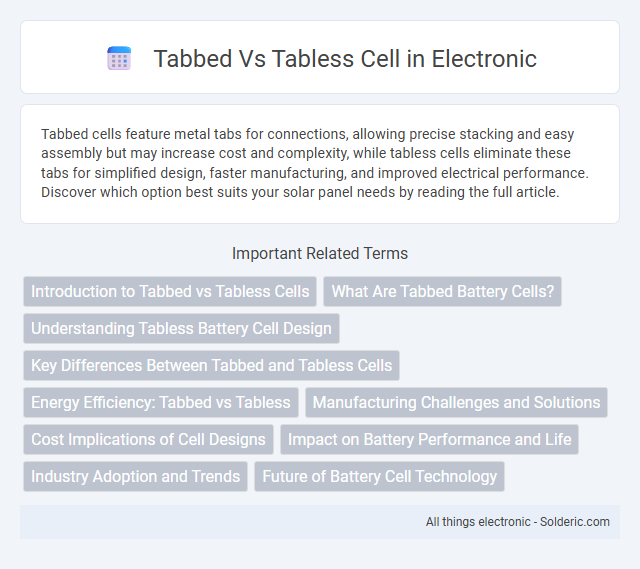Tabbed cells feature metal tabs for connections, allowing precise stacking and easy assembly but may increase cost and complexity, while tabless cells eliminate these tabs for simplified design, faster manufacturing, and improved electrical performance. Discover which option best suits your solar panel needs by reading the full article.
Comparison Table
| Feature | Tabbed Cell | Tabless Cell |
|---|---|---|
| Definition | Cell aligned using tab stops for precise column alignment | Cell without tab stops, relying on default or manual alignment |
| Alignment Control | High - allows exact positioning using tabs | Low - depends on default settings or manual spacing |
| Use Case | Complex tables requiring consistent alignment | Simple tables or layouts without strict alignment needs |
| Flexibility | More flexible with content positioning | Less flexible, limited to cell boundaries |
| Complexity | Higher - requires managing tab stops | Lower - straightforward cell structure |
| Rendering | Depends on tab stop support in renderer | Consistent across all renderers |
Introduction to Tabbed vs Tabless Cells
Tabbed cells in integrated circuits feature alignment tabs that aid in precise chip placement and enhance mechanical stability during assembly. Tabless cells eliminate these tabs, allowing for reduced cell height and increased routing flexibility, which optimizes area efficiency and improves timing performance. This design choice significantly impacts manufacturing yield and electrical characteristics in semiconductor fabrication.
What Are Tabbed Battery Cells?
Tabbed battery cells feature metal tabs that extend from the cell's surface, enabling efficient electrical connections and easier integration into battery packs. These tabs improve heat dissipation and reduce internal resistance, enhancing the cell's performance under high current loads. Understanding the role of tabs helps you select the right battery design for applications requiring reliable power delivery and thermal management.
Understanding Tabless Battery Cell Design
Tabless battery cell design eliminates traditional tabs, reducing internal resistance and improving heat dissipation, which enhances overall cell performance and longevity. Unlike tabbed cells, tabless cells feature a uniform current collection layer that allows for faster charging and more efficient energy distribution. Your battery systems benefit from increased power density and reliability due to this innovative architecture.
Key Differences Between Tabbed and Tabless Cells
Tabbed cells contain predefined indentations or stops for organizing text and aligning content visually, enhancing readability in structured data entry. Tabless cells lack these predefined stops, providing a continuous space that allows unrestricted text flow, which is ideal for freeform content or when precise alignment is unnecessary. The fundamental difference lies in the presence of tab stops in tabbed cells versus the continuous, unsegmented layout of tabless cells, impacting formatting and data presentation efficiency.
Energy Efficiency: Tabbed vs Tabless
Tabbed cells feature metal tabs connecting individual cells, which create slight resistance and energy loss, reducing overall efficiency. Tabless cells eliminate these tabs by integrating current collection across the entire cell surface, minimizing resistive losses and improving energy yield. Solar panels using tabless technology demonstrate higher efficiency and better performance under partial shading conditions compared to traditional tabbed designs.
Manufacturing Challenges and Solutions
Tabbed cells require precise laser or mechanical tabbing, which often leads to alignment issues and increased production time impacting overall yield. In contrast, tabless cells eliminate the need for physical tabs by utilizing laser patterning, reducing resistance losses and simplifying interconnection processes. To address manufacturing challenges, advanced laser scribing technologies and automated handling systems are employed to enhance precision and throughput in both tabbed and tabless configurations.
Cost Implications of Cell Designs
Tabbed cell designs generally incur higher manufacturing costs due to the complexity of adding metal tabs for electrical connections, which require additional materials and labor. Tabless cells reduce production expenses by eliminating these metal tabs, simplifying the manufacturing process and improving material utilization efficiency. This cost efficiency is especially significant in large-scale photovoltaic module production, where marginal savings per cell translate to considerable financial benefits.
Impact on Battery Performance and Life
Tabbed cells offer lower internal resistance due to shorter electron travel paths, improving battery performance and enabling higher current output without excessive heat generation. Tabless cells distribute current more evenly, reducing hotspots and thermal stress, which enhances battery lifespan and safety under repeated charge-discharge cycles. The choice between tabbed and tabless designs significantly influences thermal management and long-term durability in lithium-ion batteries.
Industry Adoption and Trends
Tabbed cells remain widely adopted in telecommunications for organizing and mapping large-scale fiber optic networks due to their ease of access and scalability. Tabless cells are gaining traction in urban infrastructure projects and data centers, offering enhanced flexibility and reduced physical space requirements, aligning with modern smart city and cloud computing trends. Your choice between tabbed and tabless cells should consider evolving industry standards prioritizing efficiency, maintenance, and integration with automated management systems.
Future of Battery Cell Technology
Tabbed battery cells rely on physical tabs to connect the electrode materials, which can limit scalability and increase manufacturing complexity. Tabless cells eliminate these tabs, enhancing current density and thermal management, leading to faster charging and improved battery lifespan. Advances in tabless technology are shaping the future of electric vehicle batteries by enabling higher energy density, reduced weight, and more efficient thermal control.
Tabbed vs Tabless cell Infographic

 solderic.com
solderic.com